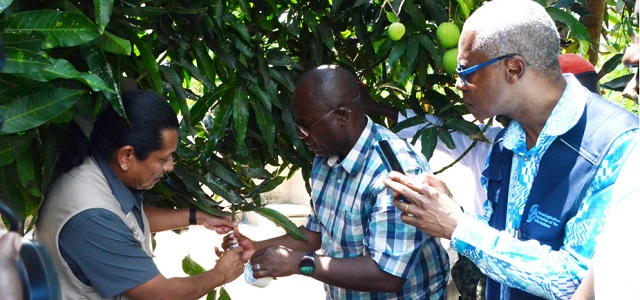
FAO and agriculture ministry respond to plight of fruit farmers in western Uganda
Kampala, Uganda | RONALD MUSOKE | The Food and Agriculture Organization of the United Nations (FAO) in collaboration with the International Institute of Tropical Agriculture (IITA) and Uganda’s agriculture ministry have teamed up and responded to the plight of mango farmers in the southern district of Ntungamo in their fight against the Mango mealybug— one of the most destructive pests of mangoes.
The Mango mealybug which is locally called Kanyananga- Oruhumbo, was first reported in November, last year, in Ntungamo District, near the Uganda-Rwanda border and since then local government has been battling the pest with less success.
The Mango mealybug pest which has a waxy covering substance which protects the pest against any pesticide spray making it extremely difficult to control can cause up to 100% yield loss if not handled quickly.
In response, the Ministry of Agriculture, Animal Industry and Fisheries supported by FAO and IITA, has released biological control agents (two parasitoid wasps- Gyranusoidea tebygi and Anagyrus mangicola) to control the pest. The release followed a scientific review by both FAO and the agriculture ministry to ensure the introduction of the wasps is safe and effective.
The agriculture ministry, FAO and other partners believe that the biological control agents (wasps) will relieve the stress of farmers, who, fearing food insecurity and income loss, hired fumigators to spray their mangoes around July/August, this year.
According to Uganda’s agriculture ministry, processing of mango into juice is growing but pests are hampering the growth in the processing industry for Uganda.
Fred Bwiino Kyakulaga, the Minister of State for Agriculture said Oct.19 during the release of the biological control agents that it is important that farmers report any new pest to any agricultural staff in their communities and that all the officers, leaders and farmers play their roles to support the biological control of these pests. This will help us to manage the pest before it spreads deeper inland into other areas.
He said despite government efforts to transform the 38% of the population still stuck in the subsistence economy to the money economy; while increasing production, productivity, value addition and agro industrialization, the agriculture sector is still faced with many challenges including diseases and crop pests such as Mango mealybug.
Speaking at the same event, Antonio Querido, the FAO representative in Uganda said millions of dollars are spent to combat pests, money and investment that could have gone into other targeted agricultural investments, resulting in significant agricultural transformation and positive outcomes for farmers, agri-preneurs, and actors along different agriculture value chains.
“FAO has, for instance, in response to mango mealybug of concern here in Ntungamo and the country at large, spent about US$200 000 (about Shs 760 million) in capacity development, mobilization and raising of insects that can control mango mealy bug in Uganda,” Querido said.
In 2017 and 2018, FAO contributed US$500,000 (Shs 1.9billion) to government efforts in building capacity for management of the Fall Army Worm in Uganda. In 2020 and 2021, about US$11 million (about Shs 41billion) was mobilized for responding to desert locusts including the procurement of vehicles, equipment, pesticides, awareness, and training and on other innovations,” he said.
“Plant pests have always been a challenge for agriculture production. We have had to play catch up to develop the technologies to gain the upper hand to reduce their impact. In a globalized world, we have seen that pests move further and faster more than ever. Climate change is facilitating this”, the FAO Country Representative added.
The Ntungamo District Local Government is optimistic that the introduction of the biological control agent will restore farmers’ hope and mango farming in the area.
“We thank the Ministry and FAO for the swift response to managing the mango mealy bug, which destroys leaves and fruits. This will ensure that the pest is contained and does not spread to other areas”, said Sam Mucunguzi, the chairperson of Ntungamo District.
“Although farmers have registered losses this season, we believe that since a solution has been introduced, the next season will be better”, he added.
First reported in Rwanda in 2019 and Burundi in 2020, the Mango mealybug attacks over 100 plant hosts and mangoes are most preferred. The pest has other alternative hosts including citrus, guava, bananas and pawpaws.
It can cause 89-100% yield loss in severely affected mango orchards and is very hard to control by pesticide spray since it has a waxy covering substance which hinders the pesticide to penetrate and kill the pest.
Fungicides will not work because this is an insect pest and not a disease. Since they multiply in numbers rapidly, Mango mealybug is also known to develop resistance to many pesticides and some of these pesticides are restricted by international trade partners including the European Union.
It is thus recommended that the safest and most effective control of the Mango mealybug is by biological control using parasitoid wasps. The wasps have been successfully utilized in Mango mealybug control in West Africa.
According to the Centre for Agriculture and Bioscience International (CABI), the mealybug feeds on the tree and produces droppings which make the leaves black and sticky. This lowers the strength of the tree, and its production of mangoes.
During a heavy attack, a whole part of the tree looks blackish in colour. This insect pest lowers the yield and quality of the mango and can be passed from one tree to another, by wind, water, contaminated farm equipment and people.
The Mango mealybug colonies appear as white masses under the leaves of the mango and can be mistaken for a fungus. The white mass is just thousands of mealybugs feeding on the leaves, sucking its juices.
****
 The Independent Uganda: You get the Truth we Pay the Price
The Independent Uganda: You get the Truth we Pay the Price



